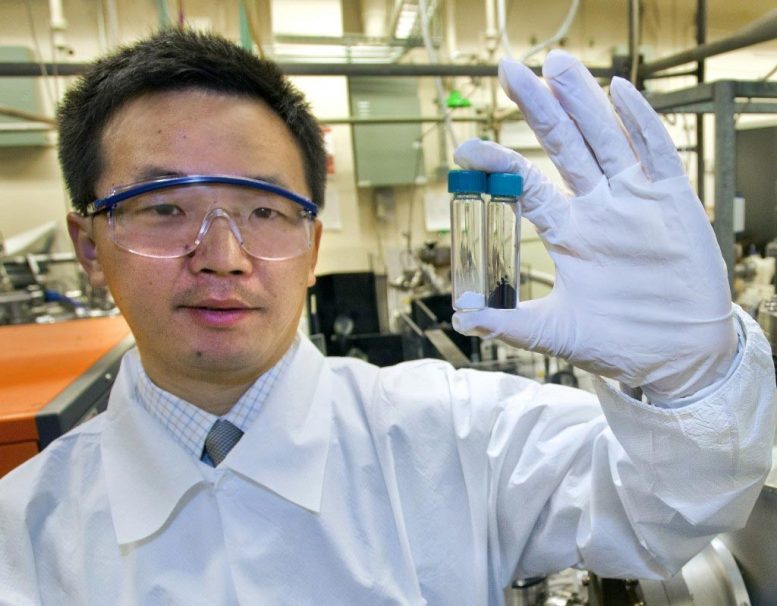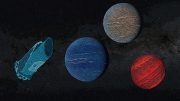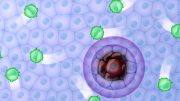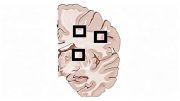
Berkeley Lab’s Samuel Mao used disorder engineering to transform titanium nanocrystals into highly efficient solar hydrogen photocatalysts, a transformation marked by turning the crystals from white to black. Credit: Roy Kaltschmidt
Scientists have developed black titanium dioxide nanoparticles that are able to absorb infrared as well as visible and ultraviolet light, improving the efficiency with which black titanium dioxide can use sunlight to split water molecules for the production of hydrogen.
A unique atomic-scale engineering technique for turning low-efficiency photocatalytic “white” nanoparticles of titanium dioxide into high-efficiency “black” nanoparticles could be the key to clean energy technologies based on hydrogen.
Samuel Mao, a scientist who holds joint appointments with Berkeley Lab’s Environmental Energy Technologies Division and the University of California at Berkeley, leads the development of a technique for engineering disorder into the nanocrystalline structure of the semiconductor titanium dioxide. This turns the naturally white crystals black in color, a sign that the crystals are now able to absorb infrared as well as visible and ultraviolet light. The expanded absorption spectrum substantially improves the efficiency with which black titanium dioxide can use sunlight to split water molecules for the production of hydrogen.
“We have demonstrated that black titanium dioxide nanoparticles are capable of generating hydrogen through solar-driven photocatalytic reactions with a record-high efficiency,” Mao said in a talk at the American Chemical Society (ACS)’s national meeting in New Orleans.
“The synthesis of black titanium dioxide nanoparticles was based on a hydrogenation process in which white titanium dioxide nanocrystals were subjected to high pressure hydrogen gas,” said Mao. “The unique disordered structure creates a photocatalyst that is both durable and efficient, and gives titanium dioxide, one of the most-studied of all oxide materials, a renewed potential.”
The promise of hydrogen in batteries or fuels is a clean and renewable source of energy that does not exacerbate global climate change. The challenge is cost-effectively mass-producing it. Despite being the most abundant element in the universe, pure hydrogen is scarce on Earth because hydrogen combines with just about any other type of atom. Using solar energy to split the water molecule into hydrogen and oxygen is the ideal way to produce pure hydrogen. This, however, requires an efficient photocatalyst that water won’t corrode. Titanium dioxide can stand up to water but until the work of Mao and his group was only able to absorb ultraviolet light, which accounts for barely ten percent of the energy in sunlight.
In his ACS talk, titled “Disorder Engineering: Turning Titanium Dioxide Nanoparticles Black,” Mao described how he developed the concept of “disorder engineering,” and how the introduction of hydrogenated disorders creates mid-band gap energy states above the valence band maximum to enhance hydrogen mobility. His studies have not only yielded a promising new photocatalyst for generating hydrogen, but have also helped dispel some widely held scientific beliefs.
“Our tests have shown that a good semiconductor photocatalyst does not have to be a single crystal with minimal defects and energy levels just beneath the bottom of conduction band,” Mao said.
Characterization studies at Berkeley Lab’s Advanced Light Source also helped answer the question of how much of the hydrogen detected in their experiments comes from the photocatalytic reaction, and how much comes from hydrogen absorbed in the titanium oxide during the hydrogenation synthesis process.
“Our measurements indicate that only a very small amount of hydrogen is absorbed in black titanium dioxide, about 0.05 milligrams, as compared to the 40 milligrams of hydrogen detected during a 100 hour solar-driven hydrogen production experiment,” Mao said.









Does this material have the structure of anatase or rutile?